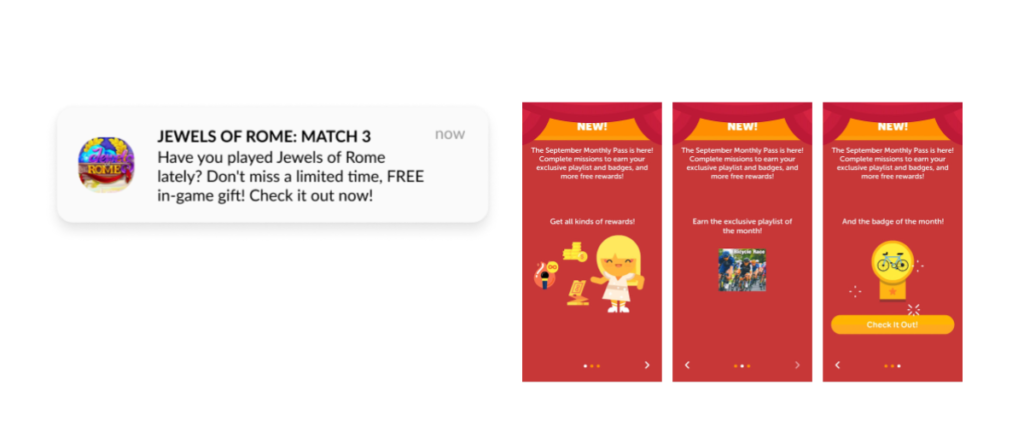Engage, Retain, Earn: Growth Strategy for Game Apps [Based on Data]
Guest Posts
September 13, 2022
This is a guest post by Pushwoosh
According to the most recent Pushwoosh research, game apps can make a quantum leap in their growth rate if they improve… engagement with their communications! Higher CTRs are found to correlate with higher in-app user activity; this, accordingly, leads to higher user retention and lower churn. With higher traffic to the app and in-app conversions that follow, a game app can stay afloat and far beyond its competitors.
Based on the findings, Pushwoosh shares a growth-oriented marketing strategy backed up with 2022 data analysis. For game apps, that will be a chance to achieve their desired metrics without compromising cost-efficiency.
Level 1: Engage your game app users
For many successful mobile games, the journey to high earnings starts from getting players engaged.
- Focusing on user engagement is especially beneficial if your game app monetization model implies showing ads to your players. In this case, you want to have a stable flow of incoming traffic. Push notifications can help you attract gamers back to your app.
- And if you gain from in-app purchases, you want to have a multi-touchpoint communication with each customer until they finally convert, so engaging users with new offers in push notifications will make sense too.
Here is how you get started:
1. Maximize your opted-in audience
The more players will be receiving your push notifications, the more of them will actually click on your message and join the number of your daily and monthly active users, Pushwoosh data has confirmed this.
To achieve a higher push notification opt-in rate, explain the value of opting-in to your users and deliver on your promise in every push to keep players opted-in.
From our experience, gamers like it when an app rewards them with some in-game extras:

2. Boost your push notifications clickability
Game apps with high opt-in rates normally have no problem with getting high CTRs, our data analysis has shown. If you need a little extra kick here, try working with your push notification copy. An irresistible CTA is a must; apart from the offer, the language of your message matters. Where, if not in a game app push, you can dare to be playful, teasing or even provocative!

3. Aim for higher numbers of DAU and MAU
You’ve done a great job engaging your mobile game audience with push notifications. Now you’re one step away from achieving significant numbers of daily and monthly active users — at least, this is what we have observed for our data sample.
Keep sending scheduled push notifications with engaging offers on a regular basis, and you may achieve an incredible 17% increase in DAU in a few months, as Bladestorm’s GC.SKINS app did.
Should you aim at getting higher stickiness rates, too, in order to grow faster?
You don’t have to concentrate your energies on pursuing a higher stickiness rate to ensure a solid game app growth rate. According to our data, game apps whose stickiness rates are around the median (between 16% and 32%) show the most notable growth.

The takeaway advice? Focus on your messaging engagement, and app engagement will follow.
Level 2: Retain players in your game app
In the fast-paced world of mobile gaming, you’ll only retain a customer for the long-term if you’ve hooked them on Day 1. Pushwoosh data has proved that a solid D1 retention rate is associated with higher D7 and D30 retention rates. And healthy retention rates (around the median values) are associated with confident app growth.

Do these insights motivate you to up your retention game? Here is your action plan:
1. Boost D1 Retention with a captivating onboarding flow
Go beyond a technical explanation of how your app works — greet your newcomers with a welcome gift that will make it easier for them to start playing and allow them to enjoy your game even more.

2. Encourage user activity to bolster D7 Retention
Did you know that every push you send to your game app users is a real chance to impress → engage → retain them? We’ve discovered a very pronounced linear dependency between User CTRs and D1, D7, and even D30 Retention in game apps. So don’t hesitate to compliment your user every time they come back to your app — a small bonus or another sticker for a regular activity will go a long way when it comes to retaining a player.

3. Keep players entertained to have D30 Retention at a high level
The common problem of game apps is that users get bored, and as a marketer, you can’t do anything about it… or can you? We encourage you to test which re-engagement activities work for your case. For example, target specifically those players who’ve been less active lately, or, right the opposite, keep throwing down new challenges to your most engaged audience segment — so that they stay this way for long.

Level 3: Drive your game app revenue
Mobile games that have implemented the engagement- and retention-focused tactics described above tend to achieve their desired results in conversions and revenue. Based on the empirical data analysis, we can state this with confidence.
For instance, one of the Pushwoosh customers collected all the feats: from the opt-in rate being 3 times higher than the median to a 10X higher App Growth Rate, and this game app earns up to $3.8k from one push!
If you aim at similar results, you may want to adopt the best practices:
If you monetize your mobile game with in-app advertising
Strengthen your incoming traffic flow by promoting daily, weekly, and monthly offers via push notifications. For even stronger engagement, you may want to take an omnichannel approach and add a gamification factor.
Bladestorm’s GC.SKINS app, for example, invites its users on a scavenger hunt for promo codes that it shares on its social media accounts. The ultimate destination where users should arrive with the code is, of course, the game app.

Is this extra stop on social media necessary? Not really, but it looks a bit more intriguing than a straightforward promo code sharing, and a little challenge is what all gamers like, isn’t it?
If you earn from in-app purchases
Experiment with special offers and audience segments that receive them. Obviously, promoting new in-game items works, but won’t exclusive seasonal objects be more tempting?
Certainly, broadcast offers sent to your entire user base work nicely, but what if you target a special offer only at those who’ve already purchased anything in your game?
Brainstorm ideas, test them, analyze the results, and reiterate to achieve higher conversions and earn more from every push you send.
Level 4: Keep scaling
As you’ve achieved growth in your key engagement, retention, and revenue metrics, you may now wonder how to evaluate your ultimate app growth. Should your mobile game audience expand even faster? Or should you put any constraints to its growth? In other words,
Can a game app grow too fast?
According to our data study, yes, overly rapid growth may lead to problems with user retention. Excessive user acquisition is as alarming as a failure to acquire any significant number of new users – both result in low Retention Rates (on Day 1, 7, and 30). And when your Churn Rates start to increase, your App Growth Rate falls down. What an unfortunate cycle!

To avoid falling into a similar tendency, keep an eye on both retention and acquisition strategies. Ensure you’re only targeting your campaigns at relevant audiences, whatever the essence of the campaign is.
Read more about how to prevent and minimize user churn early on in a dedicated blog post
Bottom Line: Grow Your Mobile Game with Intelligence
Equipped with the most recent data-based insights, you should be able to develop a robust growth strategy for your mobile game.
Track your key metrics, assess them against the gaming industry benchmarks, and never cease to experiment. It’s a fun field you’re working in, so may there always be time for play!

About the author
Max Kuzakov is a Senior Customer Success Manager @ Pushwoosh, the mobile-inspired customer engagement platform for high achievers. Using Pushwoosh’s tech-easy solutions, 80 000 gaming and non-gaming companies have built effective communication strategies with the use of push notifications, in-app messages, emails, SMS, WhatsApp, and omnichannel triggered messaging.
- Engage, Retain, Earn: Growth Strategy for Game Apps [Based on Data] - 15 September 2022
- How to do App Store Optimization step-by-step: a full cycle of ASO in the App Store and Google Play - 9 August 2022
- The Importance of A/B Testing - 13 January 2022

